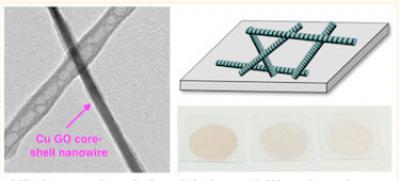Researchers at the University of California at Berkeley and the Lawrence Berkeley National Laboratory have developed a new solution-based, cost-effective way to wrap reduced graphene oxide around the surface of ultrathin transparent conducting copper nanowires. The technique aims to significantly improve the stability of the wires in air and reduce the amount of light scattered by the materials.

Thin films made of the wires might be used in optoelectronics devices, particularly in displays and flexible electronics. Metal nanowire films could make good replacements for the expensive and brittle indium tin oxide (ITO) in next-generation electronics, thanks to their excellent electrical and optical properties and the fact that they can be easily processed in solution.
Copper nanowires are as electrically conducting as silver ones while being 20 times cheaper. Also, because copper nanowires with diameters of less than 20 nm can be produced, they scatter light a lot less than their thicker silver nanowire cousins. Copper nanowire-based transparent films also show good optical and electrical properties.
Wrapping graphene around these nanowires not only improves their stability in air but also the electrical and thermal conductivity of the metal wires. However, plasma chemical vapour deposition at temperatures as high as 500700°C is required to grow the thin layer of graphene on the nanowires a method that is still too expensive for producing large quantities of the material.
The scientists have addressed this problem with a room-temperature solution-based technique to produce high-quality ultrathin copper reduced-graphene-oxide-core-shell nanowires. The researchers prepared graphene-oxide nanosheets with an average diameter of around 10 nm and diluted in methanol. They then added the copper-nanowire suspension to the dilute graphene-oxide solution and placed the mixture in an ultrasonic bath for a few minutes. During this step, the graphene-oxide nanosheets self-assemble onto the surface of the copper nanowires.
The scientists report that films made from these coated copper nanowires are highly transparent and at the same time have low electrical resistivity. They are very stable in air and perform well at high temperatures and in humid environments. They can even be mechanically deformed and are thus ideal for making flexible electrodes. They do not scatter light, so could be used in display applications.
This work demonstrates a new approach to improve and stabilize ultrathin metal nanowires, and could represent a step towards commercializing copper nanowires as low cost transparent conductors for optoelectronic devices.
Size mismatch
What size graphene nanosheets are used? How can much bigger graphene nanosheets be wrapped around copper nanowires? How many turns do they make to wrap around?